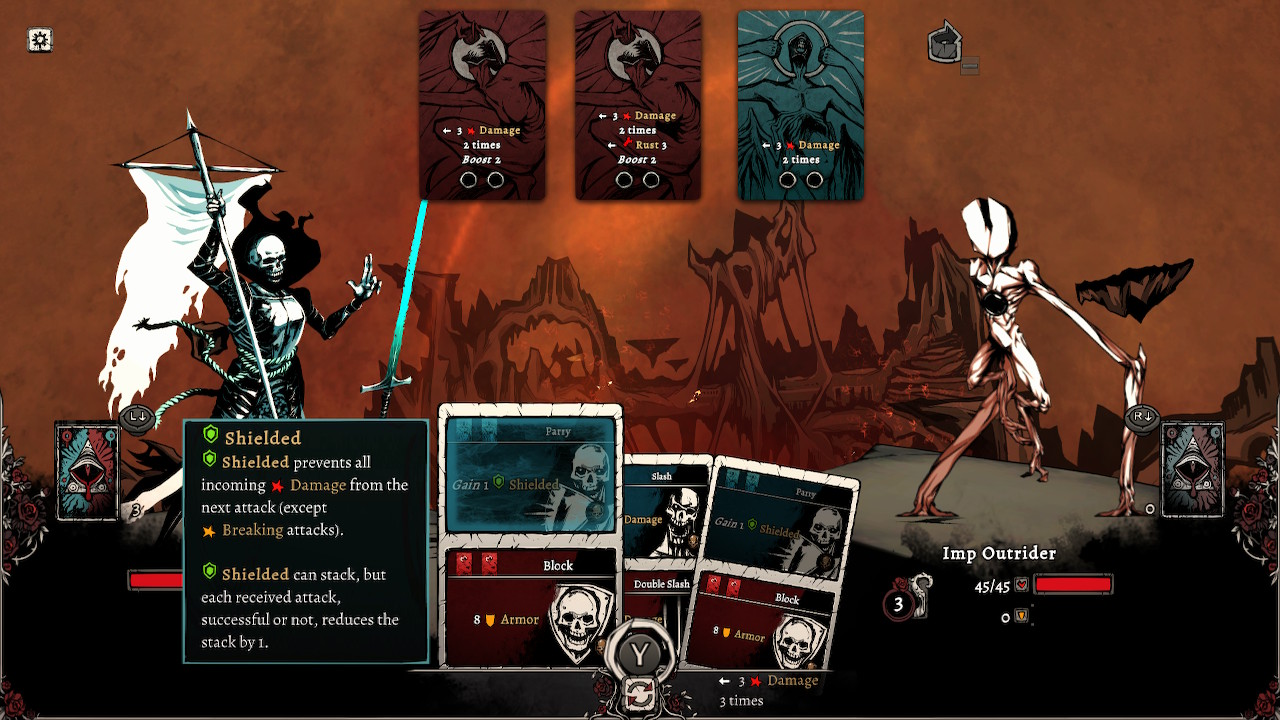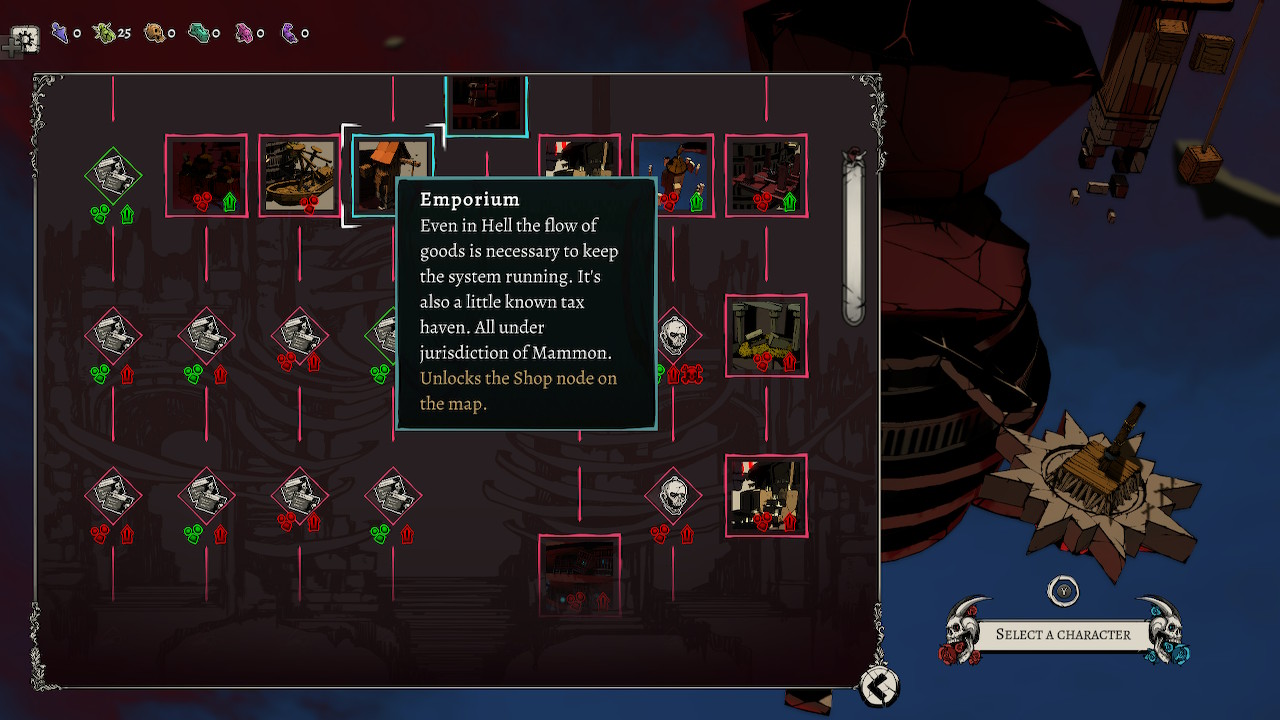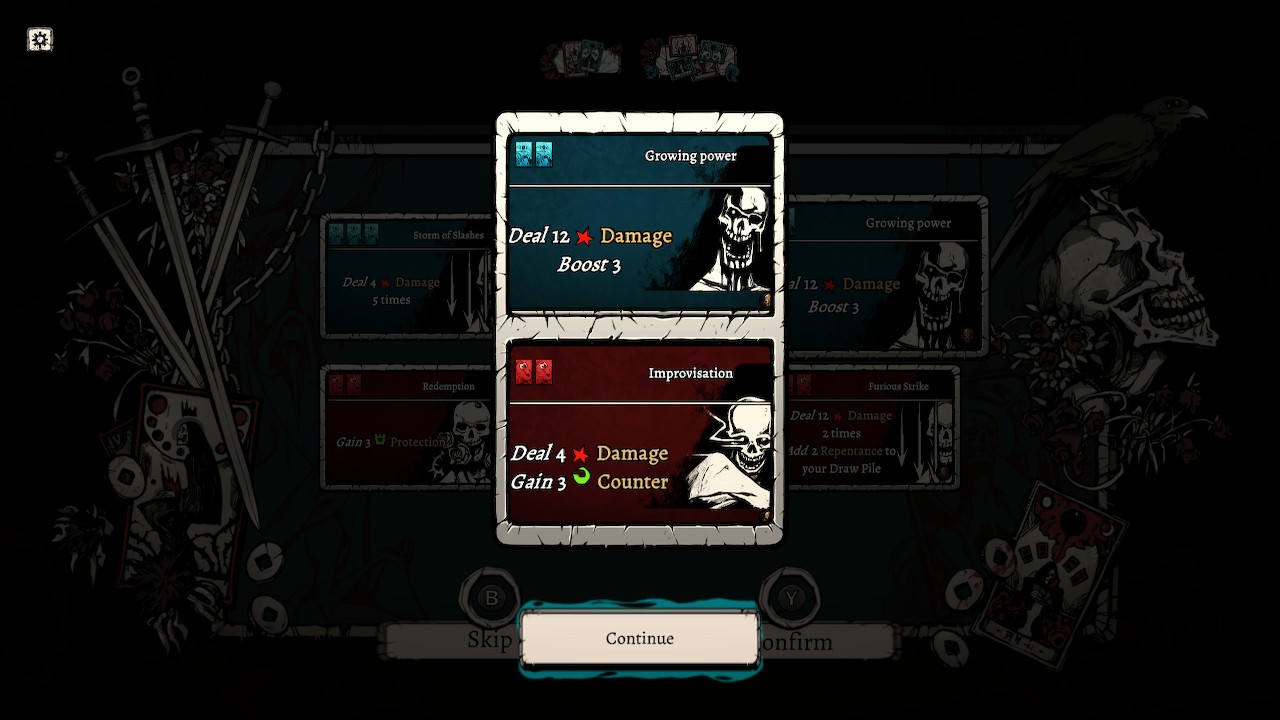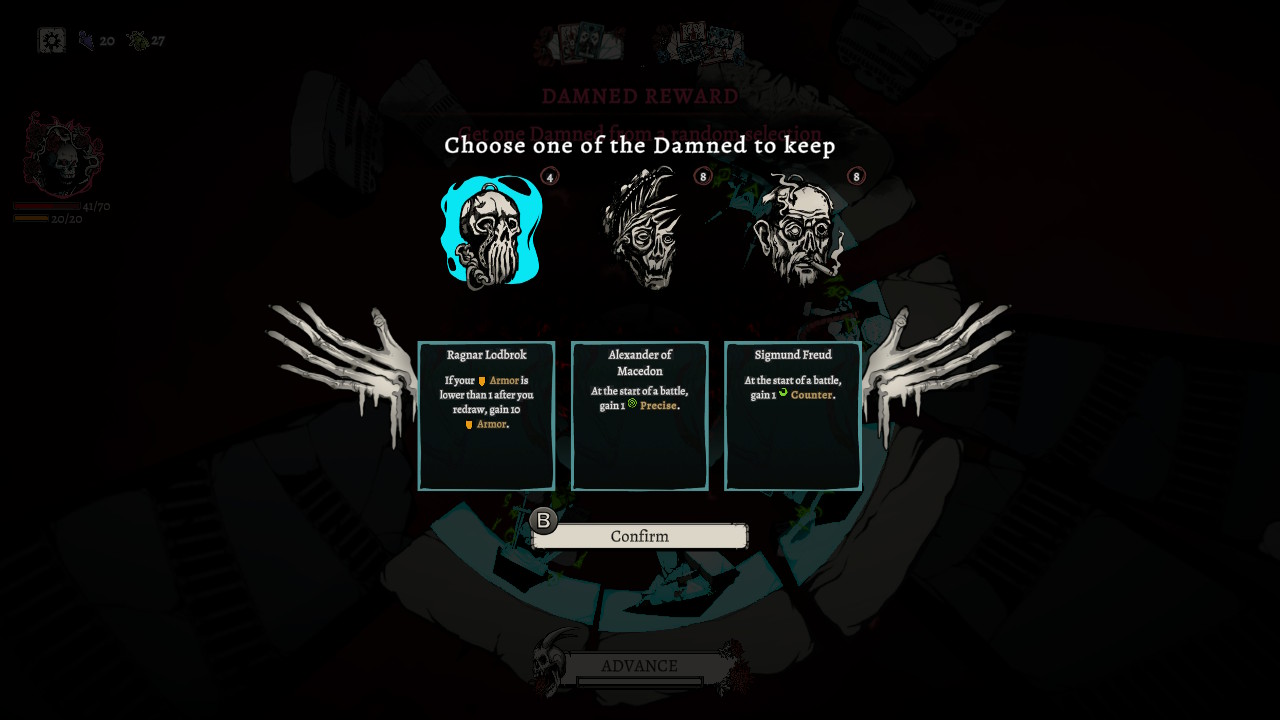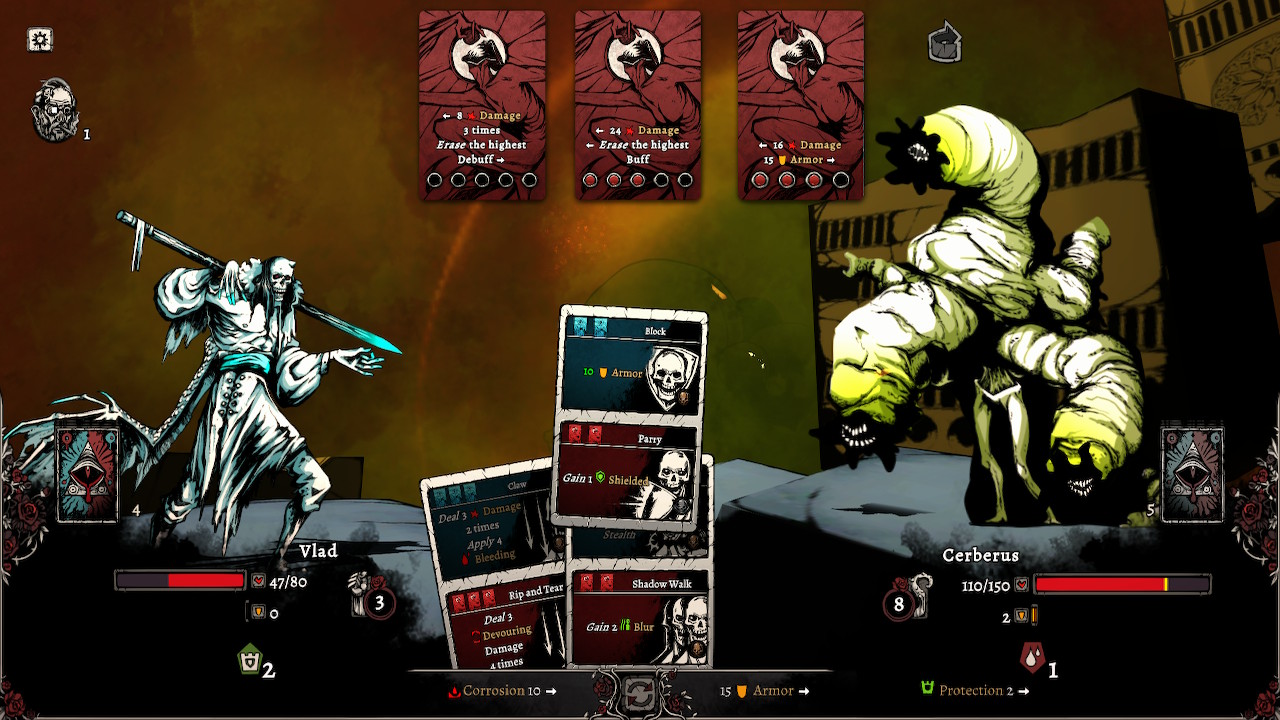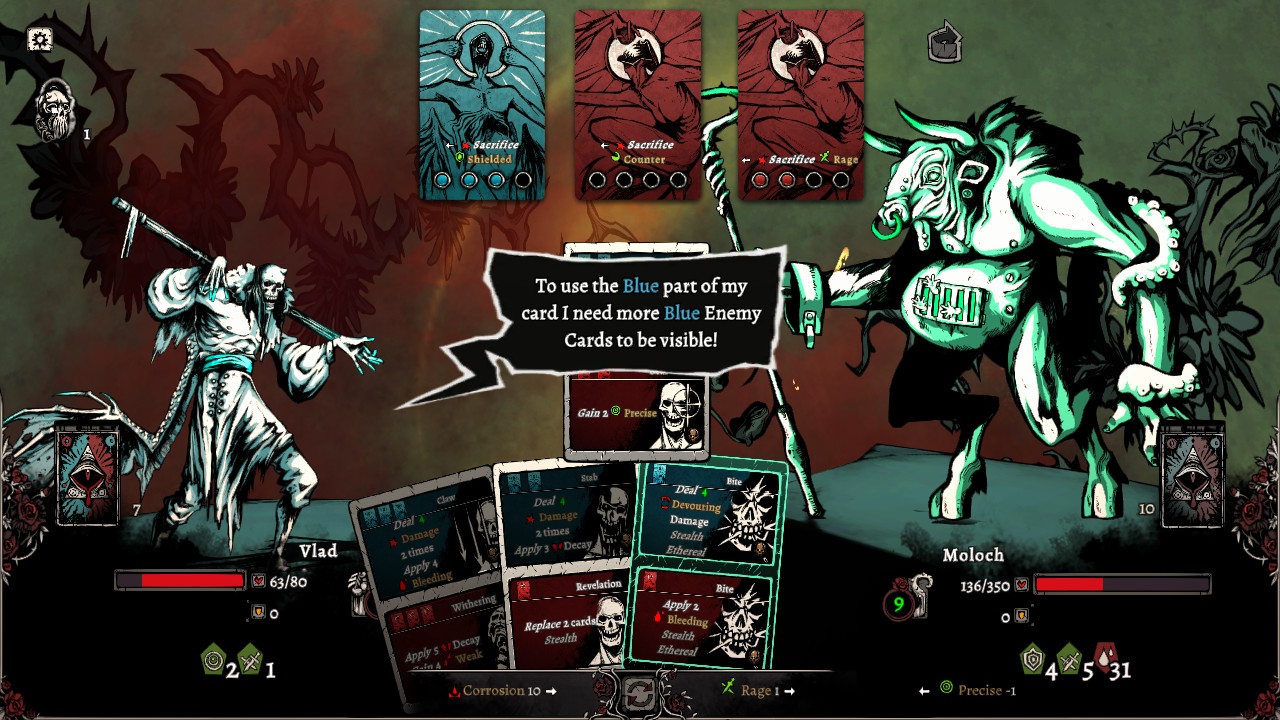A rogue-deck adventure?
Nadir: A Grimdark Deck Builder is a card-based battle game where you take on the role of a damned soul who battles your way through the pits of Hell to collect resources. It features deck building, multiple ways to attack, and a rather ingenious combat mechanism I don’t think I’ve seen before, forcing you to balance your attacks against the threat of the enemy’s retaliation.
The back story is that you’re a historical dead person—starting with “Jeanne” (D’ Arc), later unlocking Vlad (Tepes) and (Hernan) Cortes—trying to build your own power base in the land of the damned. Putting Saint Joan in the same company as those two men, let alone Hell, is an odd choice, but here we are.
Each character has a small core deck of cards and hit points. Jeanne also starts with armor points, which the other two can acquire through play. There are four realms of Nadir you can travel through, though two are locked until you collect enough resources.
Each character and enemy realm has its own style. Jeanne is a straight-up combatant, using attacks to punch through enemy defenses. Vlad specializes in using debuffs to weaken his enemy. Cortes can call on servant wraiths to either attack or enhance his protection.
On the enemy side, depending on which kind of demon you fight (they’re sorted by four of the seven deadly sins), you can fight creatures that attempt to sap your strength, bleed you dry, or just straight-up crush you.
A key part of the battle is how you play your cards. The player and the enemy both (generally) have three cards each, divided into red and blue effects, with the enemy’s cards being either wholly red or blue. The player’s cards have a blue effect on top, and a red effect on bottom. In addition, these effects have a cost of 1-3, and can only be played if the enemy has the requisite number of that color showing. So, if you want to play a 2-point Blue attack, the enemy needs to have two blue cards showing.
Here’s where it gets tricky. The enemy doesn’t attack on its own. By playing a card, you charge up the enemy cards until they’re full, then they’re activated at the end of your turn. So, if an enemy red card has five dots on it (a powerful attack), you can play up to four dots worth of your own red attacks before it comes into play.
Another level of complexity is that when you play a card with multiple dots, they’re split evenly among the enemy cards. If you’re not careful, you can have two or three attacks coming back on you at once.
The player can also “delay,” which means he turns in all his cards to draw a fresh set, causing the enemy cards to flip sides and colors. This can be handy if you’re trying to avoid a massive attack, but the flipped cards don’t disappear; they’re just waiting until the reverse side gets filled or you delay again, then they return.
The game also features a number of buffs and debuffs that can affect both you and the demons. Rust causes armor to decay, bleed causes hit point damage every time you make an attack, counter gives you a free attack after the enemy attacks you as well as healing and armor improvement attacks.
Defeat an enemy, and you get resources. Then it’s down to a lower level of hell, where you fight more enemies, buy new card effects, and combine them with old cards. The enemies get tougher as you descend, but at certain points you’ll be given the option to return to your base with what you’ve gathered so far. Eventually you’ll come to the ruler of a particular realm for a boss fight.
Die and you lose most of your resources, so, especially when you first start to play, retreating is a sensible option. But even if you don’t die, when you return to base you’ll lose all but your core set of cards. When you descend again, you’ll only have your most basic attacks.
Building your base unlocks the other characters and realms, more card options to gather, and bonuses like the ability to heal between levels.
The fun of the game is in repetition. In the first few playthroughs you’re so underpowered you’ll be killed quickly. But by accumulating resources, you become stronger. Then, you’ll learn an attack style and progress.
The big knock against the game is that it feels unfinished, with bugs getting corrected during updates, and others, well, not. Because there’s not a great deal of documentation online about it, I’m still not sure what resources I need to gather to unlock the final set of buildings. And even if you defeat a level’s Boss, the options are to return to base or to continue fighting for better resources.
That having been said, I did enjoy puzzling out the nuances of Nadir: A Grimdark Deck Builder. Once you unlock all the cards for a character you cannot only choose, but be forced to find a different play style due to the upgrade cards you’re offered. In one round, Vlad got a ton of bleed debuffs, on another, the bonus cards I was offered forced me to play a different way. But combining the active choices I make in combat with the consequences imposed on me offered a tantalizing puzzle to solve on every try.
Review: Nadir: A Grimdark Deck Builder (Nintendo Switch)
Fair
Nadir: A Grimdark Deck Builder feels unfinished in parts, but fans of card-based battle games will be intrigued by the ingenious combat mechanism that forces you to balance your attacks against the threat of the enemy’s retaliation.

